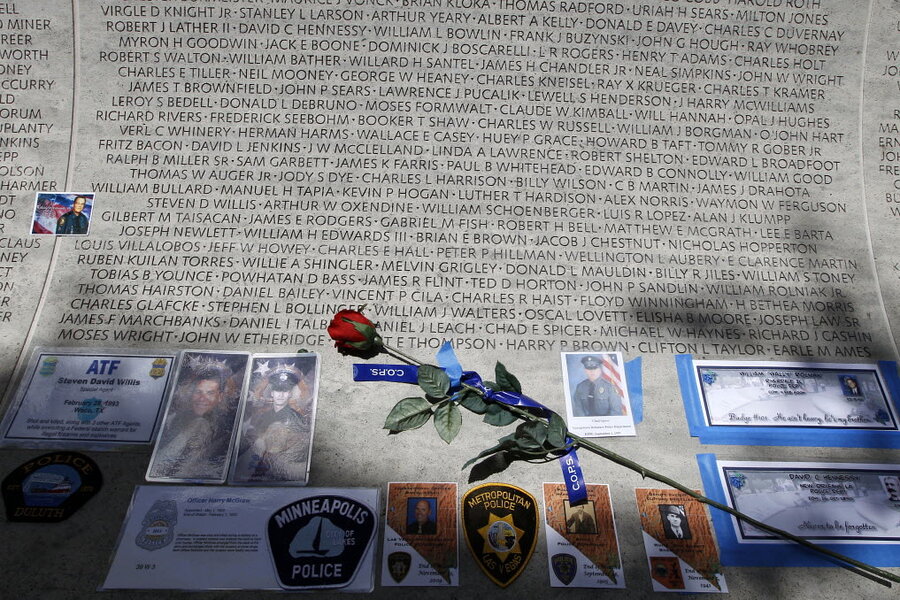Ambush killings of police spiked in 2014, but still remain rare
Loading...
| Washington
On-the-job police fatalities rose in 2014, led by a 56 percent increase in shooting deaths, according to preliminary figures released Tuesday by a nonprofit foundation.
Fifteen of the 126 police fatalities were of the ambush type that's grabbed national attention this month because of the slaying of two New York City officers.
Although the ambush assaults represent just 12 percent of the officer deaths this year, the deadly attacks match 2012 as the most on record since 1995, according the report by the National Law Enforcement Officers Memorial Fund.
The numbers point to why there’s amplified concern nationwide about how to protect those whose job description is “to protect and serve.” The news of police deaths also raises a question: Will a heightened focus on police safety coexist with a parallel movement aimed at reducing instances in which young black men are killed during encounters with police? Or will these be perceived as opposing goals?
In the case of the two slain New York officers, the alleged killer was a man who said he was motivated by the deaths of Michael Brown and Eric Garner, black men who died at the hands of police – Mr. Brown in Ferguson, Mo., and Mr. Garner in New York City.
New York police said the cop killer was Ismaaiyl Brinsley, who had shot (but not killed) a former girlfriend in Maryland before going to New York, where he killed officers Wenjian Liu and Rafael Ramos. He then ran into a subway station and killed himself while being pursued.
“With the increasing number of ambush-style attacks against our officers, I am deeply concerned that a growing anti-government sentiment in America is influencing weak-minded individuals to launch violent assaults against the men and women working to enforce our laws and keep our nation safe,” said Craig Floyd, who heads the National Law Enforcement Officers Memorial Fund, in releasing the report. “Enough is enough. We need to tone down the rhetoric and rally in support of law enforcement and against lawlessness.”
The recent police deaths have spawned public rallies in support of law enforcement, not just in New York but also in some other cities from Cleveland to Denver. The slogan “blue lives matter” has sprung up as a counterpoint to the “black lives matter” campaign that arose after Brown’s death in August.
Although the number of police fatalities rose this year, the long-term trend line is downward, led largely by a decline in gun-related deaths.
Firearms-related police fatalities peaked in 1973, the report says, when 156 officers were shot and killed. Such deaths have fallen from an average of 127 per year in the 1970s to 57 per year so far in the current decade. The figure for 2014 is 50.
Still, the latest numbers are a sobering reminder of the dangers confronting beat cops:
• Firearms-related incidents, up 56 percent from 2013, were the leading category of on-duty deaths. These included not only ambush attacks but also shooting deaths that occurred during traffic stops, pursuits, disturbance calls, attempted arrests, and investigations of suspicious persons or activities.
• Traffic-related incidents accounted for 49 officer fatalities in 2014, almost matching the 50 shooting deaths. These deaths, mostly from car crashes but also while officers were outside their vehicles, were up 11 percent from 2013.
• One officer was killed in a fire-related incident, one drowned, one was strangled to death, and two dozen died because of job-related illnesses, the report said.
To some extent, it’s clear that efforts to protect police can coexist with efforts to address the distrust with which many black Americans view police. The trend line of firearms-related officer deaths has been going down in recent years, for example, even as the “community policing” movement has put a friendlier face on patrol cops.
In New York City, violent crimes have continued to fall in 2014 even as police reforms pushed by Mayor Bill de Blasio have scaled back controversial stop-and-frisk tactics.
But the tension between the twin goals is also clear. Mayor de Blasio has become deeply unpopular with many NYPD officers – a challenge amplified by the recent officer slayings.
Some critics have said de Blasio is partly to blame for those deaths, by appearing to lend his allegiance to anti-police protesters when a grand jury decided on Dec. 3 not to indict an officer involved in the apparent chokehold death of Garner, who was being arrested for selling cigarettes illegally on the street.








